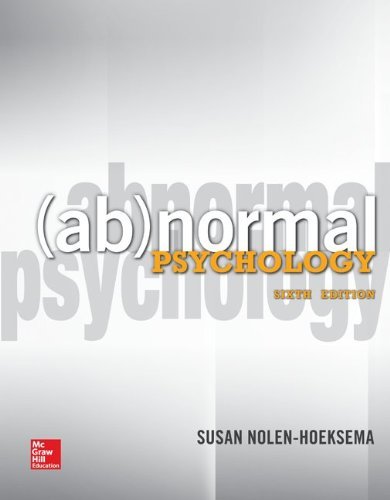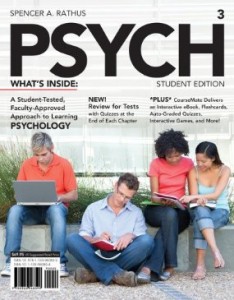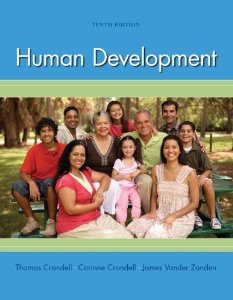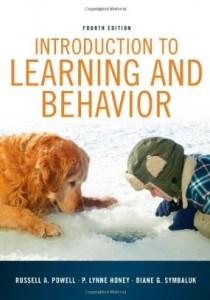Description
Abnormal Psychology Nolen-Hoeksema 6th Edition Test Bank
Abnormal Psychology Nolen-Hoeksema 6th Edition Test Bank
***THIS IS NOT THE ACTUAL BOOK. YOU ARE BUYING the Test Bank in e-version of the following book***
Name: Abnormal Psychology
Author: Nolen-Hoeksema
Edition: 6th
ISBN-10: 0078035384
Type: Test Bank
– The test bank is what most professors use an a reference when making exams for their students, which means there’s a very high chance that you will see a very similar, if not exact the exact, question in the test!
– The file is either in .doc, .padf, excel, or zipped in the package and can easily be read on PCs and Macs.
– Delivery is INSTANT. You can download the files IMMEDIATELY once payment is done.
If you have any questions, please feel free to contact us. Our response is the fastest. All questions will always be answered in 6 hours., most of the time within 30mins
We also faced similar difficulities when we were students, and we understand how you feel.
But now, with the Abnormal Psychology Test Bank, you will be able to
* Anticipate the type of the questions that will appear in your exam.
* Reduces the hassle and stress of your student life.
* Improve your studying and also get a better grade!
* Get prepared for examination questions.
*Can save you time and help you understand the material.
This is the quality of service we are providing and we hope to be your helper.
Delivery is in the next moment. Test Bank is accurate.
Prepare to receive your Abnormal Psychology Test Bank in the next moment.
If you have any questions, or would like a receive a sample chapter before your purchase, please contact us at inquiry@testbankcorp.com
Abnormal Psychology Test Bank
Abnormal Psychology Nolen-Hoeksema 6th Edition Test Bank ISBN: 0078035384
c3
Student: ___________________________________________________________________________
1. Current guidelines for diagnosing mental disorders use _____ to make diagnoses.
A. ranges of scores
B. subjective systems
C. thresholds
D. continuum models
2. The process of gathering information about an individual’s symptoms and the possible causes of these symptoms is referred to as _____.
A. assessment
B. diagnosis
C. treatment
D. study
3. Which of the following is a label for a set of symptoms that often occur together?
A. Marker
B. Typology
C. Diagnosis
D. Assessment
4. Tina’s parents are concerned because she seems to have trouble writing. She often writes her numbers backwards and misspells words. The school suggests that they seek psychological counseling, especially since the problem occurred after the family’s car accident. Why might the family need a psychologist?
A. Psychologists can assess cognitive deficits such as learning disabilities.
B. A psychologist would be more sympathetic to the parents’ concerns.
C. A psychologist could consult after ruling out biological causes for the problem.
D. Psychologists are concerned with the emotional well-being of individuals.
5. Which term refers to the accuracy of a test in assessing what it is supposed to measure?
A. Reliability
B. Validity
C. Constructability
D. Generalizability
6. Jason was taking a test to measure his general level of anxiety. When he glanced over the test, the questions seemed as though they were related to his problem. In this scenario, the test most likely had _____ validity.
A. predictive
B. concurrent
C. content
D. face
7. If a test assesses all the important aspects of a phenomenon, the test is said to have _____ validity.
A. content
B. construct
C. concurrent
D. contextual
8. Mark takes a test to measure his general level of anxiety. After taking the test, Mark realizes that the test contained questions only on the physical symptoms of anxiety and left out questions related to cognitive symptoms, which are important aspects of the phenomenon of anxiety. In this case, the test lacks _____ validity.
A. concurrent
B. content
C. face
D. predictive
9. _____ validity is the extent to which a test yields the same results as other, established measures of the same phenomena.
A. Construct
B. Concurrent
C. Content
D. Predictive
10. A test is considered to have predictive validity when it:
A. measures what it intends to measure and not something else.
B. seems on its face to measure what it intends to measure.
C. yields results similar to those of other established measures.
D. reliably represents how a person will think, feel, or behave in the future.
11. The extent to which a test measures what it is supposed to measure and not something else altogether is representative _____ validity.
A. predictive
B. concurrent
C. construct
D. face
12. A test that is consistent in measuring what it is supposed to measure is considered to have _____.
A. reliability
B. generalizability
C. validity
D. constructability
13. _____ reliability refers to how consistent the results of a test are over time.
A. Alternate form
B. Internal
C. Interrater
D. Test-retest
14. Wallace took the Stanford-Binet Intelligence Test when he was in the sixth, eight, and tenth grades. On each occasion, his test scores were practically the same. The Stanford-Binet Intelligence Test would be an example of _____ reliability.
A. internal
B. test-retest
C. interrater
D. alternate form
15. A researcher should expect low test-retest reliability for an anxiety questionnaire that measures:
A. general tendencies.
B. enduring characteristics.
C. current symptoms.
D. common tendencies.
16. Simon developed two forms of an anxiety questionnaire. In the second form, he changed the wording and order of the questions. He administered both forms to the same group of participants two weeks apart. While scoring the tests, Simon realizes that the participants’ answers to the different forms of the test are dissimilar. In this case, the tests are said to have:
A. high test-retest reliability.
B. low test-retest reliability.
C. high alternate form reliability.
D. low alternate form reliability.
17. _____ refers to the similarity in people’s answers among different parts of the same test.
A. Content validity
B. Internal reliability
C. External validity
D. Alternate reliability
18. When different individuals administer and score a test and come to similar conclusions after evaluating the same people, the test is said to have _____ reliability.
A. high interrater
B. low interjudge
C. low internal
D. high test-retest
19. Which of the following is the best method of improving the validity and reliability of psychological tests?
A. Conducting at least three trials before using them for research
B. Standardizing their administration and interpretation
C. Limiting their use to patients with severe disorders
D. Having them reviewed by professionals in the field of psychopathology
20. An initial interview in a clinical setting may include a _____ exam, to assess the client’s general functioning.
A. mental health
B. medical health
C. mental status
D. medical status
21. On Lee’s first visit to a psychologist’s office, a psychologist asks his a series of questions about his personal and family history. These questions:
A. are part of his initial interview.
B. mainly serve the purpose of putting the client at ease.
C. are just a formality with no real diagnostic value.
D. reflect the client’s ability to diagnose his own condition.
22. During an initial interview, Diane notes that her client tends to laugh excessively at his own jokes. He has disheveled hair and soiled clothes. Which types of information has Diane noted about her client?
A. Mood and affect; orientation to place, time, and person
B. Orientation to place, time, and person; thought processes
C. Thought processes; intellectual functioning
D. Appearance and behavior; mood and affect
23. In a mental status exam, when a clinician takes note of how coherently and quickly a client speaks, the clinician is assessing the client’s _____.
A. mood and affect
B. appearance and behavior
C. thought processes
D. orientation to the place, time, and person
24. In a mental status exam, the clinician will evaluate the client’s _____ by observing how well the person speaks and looking for indications of memory or attention difficulties.
A. mood and affect
B. intellectual functioning
C. appearance and behavior
D. orientation to the place, time and person
25. Which kind of interview is standardized and uses concrete criteria to score the person’s answers?
A. Initial
B. Unguided
C. Structured
D. Definitive
26. Rudolph was asked a set of questions about his symptoms in his initial interview that seemed very objective. He was surprised because his friends had told him to expect probing questions such as, “Tell me about yourself.” The clinician most likely conducted a _____.
A. behavioral observation
B. projective test
C. standard mental health exam
D. structured interview
27. Which of the following is a quick way for clinicians to determine a person’s symptoms?
A. Symptom questionnaire
B. Structured interview
C. Luria-Nebraska Test
D. Computerized tomography scan
28. The Beck Depression Inventory (BDI) is one of the most common questionnaires used to assess symptoms of _____.
A. anxiety
B. paranoia
C. depression
D. mania
29. Which of the following statements is true about the Beck Depression Inventory (BDI)?
A. It assesses whether the respondent qualifies for a diagnosis of depression.
B. It describes four levels of a given symptom of depression.
C. Respondents indicate the description that best fits how they have been feeling in the past six months.
D. Cutoff scores have been established to indicate only severe levels of depressive symptoms.
30. During 28-year-old Sophia’s second visit to the psychologist, the clinician gave her a symptom questionnaire that assessed symptoms of depression. Sophia most likely received the _____.
A. Geriatric Depression Scale
B. Beck Depression Inventory
C. Halstead-Reitan Test
D. Bender-Gestalt Test
31. Critics of the Beck Depression Inventory (BDI) argue that it:
A. is incapable of responding to the new manifestations of depressive symptoms.
B. is too easy to administer, and increases the likelihood that clients will provide false responses.
C. does not clearly differentiate between depressive symptoms and general distress related to other disorders.
D. does not prove to be adequate assessment for the complicated clinical syndrome of depression.
32. Which of the following is used to assess people’s typical ways of thinking, feeling, and behaving?
A. An intelligence test
B. A symptom questionnaire
C. A projective test
D. A personality inventory
33. Cynthia wants to become a police officer. Applicants for the police academy must take a battery of tests before admission. Cynthia took a test that had sentences describing moral and social attitudes, behaviors, psychological states, and physical conditions. She was also instructed to respond to each sentence with either “true,” “false,” or “can’t say.” Cynthia most likely took the _____.
A. Beck Depression Inventory
B. Minnesota Multiphasic Personality Inventory
C. Bender-Gestalt Test
D. Thematic Appreciation Test
34. Which of the following statements is true about the Minnesota Multiphasic Personality Inventory (MMPI)?
A. While it was being developed, a large group of possible inventory items was given only to people suffering from various psychological problems.
B. The inventory items on the original MMPI cluster into 18 scales that measure different types of psychological characteristics or problems.
C. Additional scales have been added to the MMPI-2 to assess vulnerability to eating disorders, substance abuse, and poor functioning at work.
D. It uses one validity scale to determine whether a person responds honestly or distorts her or his answers in a way that might invalidate the test.
35. Which of the following is a criticism leveled against the Minnesota Multiphasic Personality Inventory (MMPI)?
A. The norms for the original MMPI were not representative of people from a wide range of ethnic and racial backgrounds, age groups, and social classes.
B. The concurrent validity and the test-retest reliability of the MMPI have been found to be low.
C. The MMPI has limited application as a general screening device for detecting people who are functioning very poorly psychologically.
D. The MMPI cannot be translated into different languages to meet the needs of different cultural groups.
36. Clinicians will often use _____ to assess deficits in an individual’s skills or ways of handling situations.
A. cognitive tests
B. behavioral observation
C. symptoms inventories
D. personality inventories
37. An important advantage of direct behavioral observations is that:
A. it has high interrater reliability.
B. it does not rely on self-reports and self-interpretation of behaviors.
C. an individual rater can easily capture all the details of an interpersonal interaction.
D. the behavior of the individual is not forced and occurs naturally.
38. If direct observation or role-playing is not possible, clinicians may require individuals to:
A. self-discipline.
B. self-regulate.
C. self-diagnose.
D. self-monitor.
39. _____ tests are used to measure abilities such as abstract reasoning, verbal fluency, and spatial memory.
A. Intelligence
B. Personality
C. Verbal
D. Projective
40. Sarah’s parents were concerned because she seemed “slow” for her age. Sarah had a complete physical and mental examination. In addition, she took a battery of tests. The results of one test revealed that Sarah suffered from mild mental retardation. Most likely, this test was a(n) _____.
A. electroencephalogram
B. personality test
C. projective test
D. intelligence test
41. Which of the following terms is used to describe a method of comparing an individual’s score on an intelligence test with the performance of individuals of the same age group?
A. Emotional Quotient (EQ)
B. Intelligence Quotient (IQ)
C. Single photon emission computed tomography (SPECT)
D. Thematic Apperception Test (TAT)
42. The average performance score on an intelligence quotient (IQ) test is _____.
A. 50
B. 120
C. 100
D. 80







Reviews
There are no reviews yet.